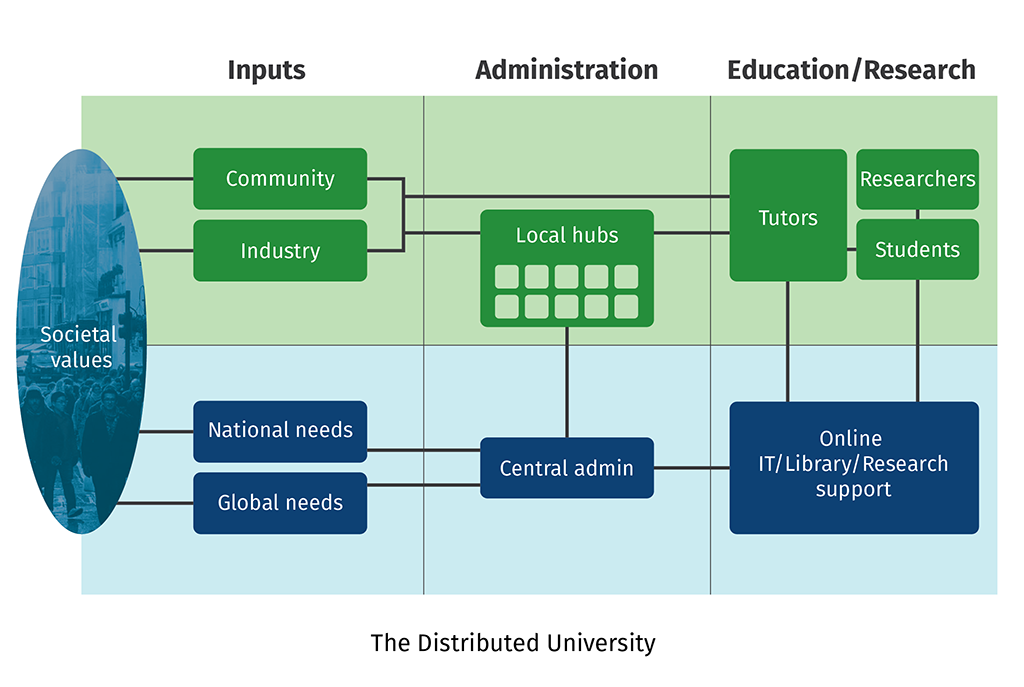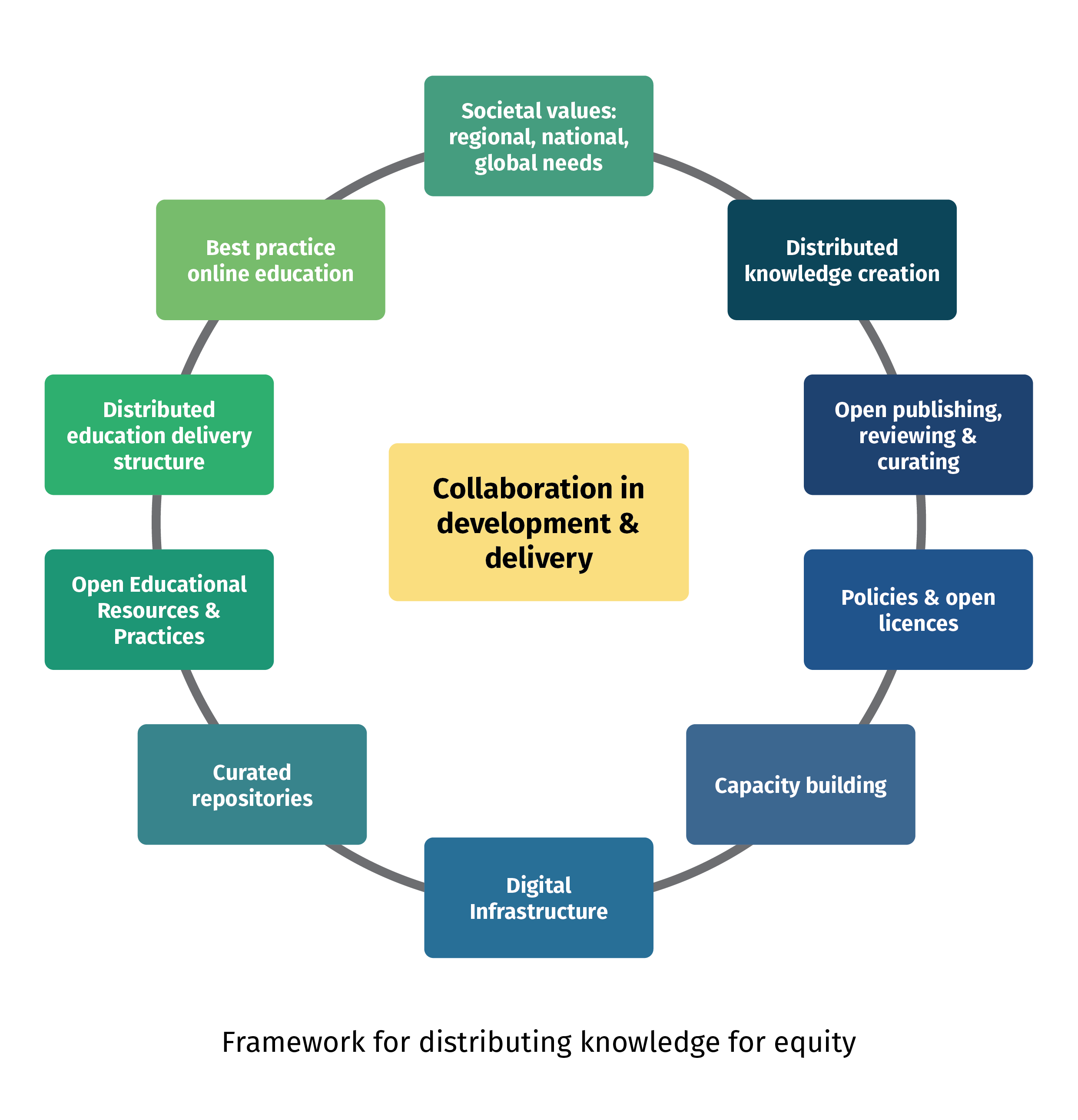Section 2. The concepts of distributed and networked education
Section outline
-
Learning objectives
By the end of this section of the course, you should be able to:
-
Describe the principles and theories underlying distributed and networked education.
-
Explain the potential of distributed and networked education to enhance access to higher education.
-
Reflect on case studies which describe distributed and networked education programmes.
By distributed education we mean the provision of education where it is needed – taking it to the student rather than the student coming to it - thus overcoming limitations of time and place. A useful definition states that distributed education occurs “when the teacher and student are situated in separate locations and learning occurs through the use of technologies (such as video and internet), which may be part of a wholly distance education programme or supplementary to traditional instruction." Hybrid education, combining online and face-to-face, has become common after the experience of the Covid pandemic, but usually implies that courses are designed and delivered centrally are partially distributed online.
Structural change can offer a more thorough distribution where students remain in their populations while they access online education. Online delivery can be supplemented through local hubs where face-to-face options are required - as shown in this diagram taken from The Distributed University for Sustainable Higher Education. The local hubs may be physical or virtual and can include international settings.

Information derived from distributed populations and incorporated into educational programmes to make them more relevant to students from those populations, and can be used to create knowledge through research including local populations. The notion of distributing knowledge creation is discussed further in a later section of the course.
Distributing knowledge and its creation should be considered within a framework for increasing knowledge for equity. The diagram below (which first appeared in Distributing knowledge creation to include under-represented populations in The International Review of Research in Open and Distributed Learning (in press)) attempts to show the various components of this framework We will be discussing each aspect at various points in this course.

There are many potential advantages of a distributed model. These include increased equity of access to education for those who cannot physically attend a central campus - due to socio-economic, disability or geographic factors. International education becomes more feasible than moving country. The impact on the climate can be markedly reduced by online rather than face-to-face education. Thanks to modern information technology, he way we access and process information today has moved on from passive learning - such as through lectures - to active learning through the internet.
By networked education we mean education that depends on contributions from different institutions. It has been formally defined as learning that fosters “collaborative, co-operative and collective inquiry, knowledge-creation and action”. It depends on “trusting relationships… and appropriate communication technologies”. Modern digital communications technology allows for connectivity that underpins the ability to create networks. The goal for networked learning, beside offering education that has benefited by collaborative development, is to promote "connections: between people, between sites of learning and action, between ideas, resources and solutions" that may pay dividends in the future practice of the students who have had the benefit of networked learning. Definitions and terminology are difficult, and we do not want to spend too much time on terminology. Here we are thinking of networks between the providers of education, although networks can be developed between learners themselves. [Note: distributed learning is a term used in artificial intelligence (AI) for the process of training machine learning models within a network. We will be touching on the importance of AI in distributed education later in the course, but not in this sense.]
A distributed and networked approach combines the benefits of both. Best practices and infrastructure can be developed and shared, higher proportions of populations at need of increased access can be reached, and research opportunities enhanced. Universities who collaborate in such a network would gain by being able to meet the mission of reaching at need populations, of having access to infrastructure and research opportunities and being able to incorporate course developments into their own programmes.
You might like to explore some of these case studies
Distributed education. Australia was a pioneer in distance education due to the large size of the country and dispersed population. We have already pointed to the regional university study hubs. Researchers from Queensland, Australia describe experience in a multi campus university in New Generation Distributed Learning: Models of connecting students across distance and cultural boundaries. A group from an open university in Pakistan report on their experience. From outside the traditional higher education sector, Peoples-uni was a fully online postgraduate distributed programme with tutors from 50 countries and students from 100 countries.
Networked education. The Biostatistics Collaboration of Australia comprises a number of universities offering a national programme of postgraudate biostatistics courses. The OERu is a network of recognised universities, polytechnics and community colleges from five continents offering online education based on Open Educational Resources. CanadARThistory is a collaboration between five educational institutions in Canada to offer open access to a course which reimagines the history of Canadian art.
An example of inequity in international education. A study, using 2022 data for higher education enrolment of international students in Australian universities, found three South-East Asian countries with very high access rates These are Singapore (403 students in Australia per 100,000 population), Brunei Daraussalam (115 per 100,000) and Malaysia (63 per 100,000). At the same time, Myanmar, Thailand, Laos, the Philippines, and Indonesia had rates less than 5 per 100,000 population.
Malaysia and Singapore together provided 47% of South-East Asian international student numbers in Australia in 2022 but comprised only 6% of the total population of South-East Asia. Indonesia provided 12% of South-East Asian international student numbers in Australia but comprised 40% of South-East Asia’s combined population.
Looking more broadly, in 2022, per 100,000 population, median rates of students coming to Australian universities were: Indian subcontinent 42, Pacific 28.9, China 10.5, South-East Asia 5.8, Sub-Saharan Africa 0.5: there was wide variation between countries within these regions.
These differences do not reflect the needs for higher education. In common with other countries, Australia’s international education is driven by the fees that students pay which are used by universities to cross-subsidise education and research.
An alternative approach would be to adopt a strategy for international education that reflects global needs - captured by the term knowledge diplomacy refers to ‘a new approach to understanding the role of international higher education, research, and innovation in strengthening relations among countries and addressing common global challenges.’ It depends on ‘collaboration, reciprocity, and mutuality.’
Distributing education online has great potential to counter inequities in access as these case studies illustrate.
-
Please reflect on what you have read about distributed and networked learning and post here how you would define these concepts and how they might be applicable in your setting.
-
